Airborne Electromagnetics to Improve Landslide Knowledge in Tropical Volcanic Environments
Abstract
1. Introduction
- (i)
- (ii)
- Definition of the internal structure of grounds by coupling field observations, geological data and AEM results;
- Building of a geological model;
- Integration of the topography and geological model in a SPBM and analysis of slope stability following a specific protocol taking field observations into account.
2. Martinique and Study Sites
2.1. Generalities
2.1.1. Geology
2.1.2. Landslides
2.2. Study Sites: Presentation and Previous Works
2.2.1. La Médaille Landslide
2.2.2. Morne-Figue Area
3. Materials and Methods
3.1. AEM Data
3.2. Interpretations and Conceptualization
3.2.1. Confrontation with Independent Data
3.2.2. Geological Modeling
3.3. Landslide Modeling
3.3.1. ALICE Presentation
3.3.2. Landslide Modeling Protocol
- (i)
- The first step focuses on the geotechnical characteristics acquired during the drilling campaigns at each site. The goal is to reduce the broad spectrum of geotechnical values because their range is quite large. Indeed, retaining geotechnical values giving recurrent instability under any saturation conditions would not be representative of real conditions, with landslides being episodically unstable. Therefore, a sensitivity study is undertaken by several iterations computing the FoS in dry and fully saturated conditions. Computations are carried out in 2D along a representative cross-section of the study site. Each geotechnical characteristic (cohesion, angle of friction, and bulk weight density) is modified iteratively by increasing its value and keeping constant values for the other two. If the results show recurrent instability under any condition (dry/saturated), the value is excluded. If the results show a recurring stability of the sites under any condition (dry/saturated), then this value is also excluded. Thus, by this sensitivity analysis, the values (cohesion, angle of friction, bulk unit weight) producing a factor of safety lower than one at a high GWL are preserved, and those producing a factor of safety greater than one for a null GWL are also preserved.
- (ii)
- The second step consists of defining the optimum cell size for ALICE® to obtain reliable results. Indeed, for the spatialized model, in raster format, the cell size can generate errors that propagate in the results [74,75]. Thus, for the two sites, simulations are carried out with cell sizes of 10 m and 5 m to observe if discrepancies can be noted between the simulations. It is not necessary to decrease the resolution because with a lower cell size, the generated profiles are too small, and it is impossible to correctly compute failures shorter than 10 m ([62,69]). Conversely, performing calculations with a larger cell size results in a loss of spatial precision, sometimes generating areas with a low or high failure probability that is not characteristic of the field reality [62]. Computations are performed with the geological models developed with the new data from the AEM data and interpretation. For this step, the best geotechnical values defined previously are used. The GWL introduced in ALICE® is constant and corresponds to full saturation conditions.
- (iii)
- The third step allows checking the influence of the GWL on the destabilization of the ground. This step takes into account the GWL recorded for the two sites from 1967 to 1968 and from 1987 to 1988 for the La Médaille landslide and Morne-Figue area, respectively. Therefore, following the different records, the maximum GWL is established with a maximum fixed at −0.5 m from the topography surface for the La Médaille landslide, −0.5 m from the topography surface for the moderately deep rotational landslide and a GWL at the level of topography for the translational shallow landslide for the Morne-Figue area. The different saturation ratios increased iteratively from dry conditions (GWL = 0) to full saturation conditions measured for each site (GWL = 1).
4. Results
4.1. Identification of Involved Materials and Geological Models
4.1.1. La Médaille
4.1.2. Morne-Figue
4.1.3. Geotechnical Models
4.2. Slope Instability Analyses
4.2.1. Identification of the Best Geotechnical Parameters
4.2.2. Identification of the Optimum Cell Size
4.2.3. Influence of the GWL
5. Discussion
6. Conclusions
Supplementary Materials
Author Contributions
Funding
Institutional Review Board Statement
Data Availability Statement
Acknowledgments
Conflicts of Interest
References
- CHARIM. Available online: http://www.charim.net (accessed on 18 November 2020).
- Van Westen, C.J. National Scale Landslide Susceptibility Assessment for Grenada. Caribbean Handbook on Risk Information Management, World Bank GFDRR, ACP-EU Natural Disaster Risk Reduction. Available online: http://www.charim.net (accessed on 18 November 2020).
- van Westen, C.J. National Scale Landslide Susceptibility Assessment for Dominica. Caribbean Handbook on Risk Information Management, World Bank GFDRR, ACP-EU Natural Disaster Risk Reduction. Available online: http://www.charim.net (accessed on 18 November 2020).
- Van Westen, C.J. National Scale Landslide Susceptibility Assessment for Saint Vincent and the Grenadines. Caribbean Handbook on Risk Information Management, World Bank GFDRR, ACP-EU Natural Disaster Risk Reduction. Available online: http://www.charim.net (accessed on 18 November 2020).
- Van Westen, C.J. National Scale Landslide Susceptibility Assessment for Saint Lucia. Caribbean Handbook on Risk Information Management, World Bank GFDRR, ACP-EU Natural Disaster Risk Reduction. Available online: http://www.charim.net (accessed on 18 November 2020).
- Van Westen, C.J. National Scale Landslide Susceptibility Assessment for Belize. Caribbean Handbook on Risk Information Management, World Bank GFDRR, ACP-EU Natural Disaster Risk Reduction. Available online: http://www.charim.net (accessed on 18 November 2020).
- Momtpelat, J.M. Unités Cartographiques et Évaluation de L’aléa Mouvements de Terrain en Guadeloupe (Antilles Françaises). Ph.D. Thesis, Institut de Physique du Globe de Paris, Paris, France, 1994. [Google Scholar]
- Peronet, L. Les Mouvements de Terrain Dans les Petites Antilles: Contribution à L’analyse Comparative de Leur Gestion de Crise. Ph.D. Thesis, Universités des Antilles, Antilles, France, 2015. [Google Scholar]
- Thiery, Y.; Reninger, P.A.; Vandromme, R.; Nachbaur, A. Contribution of Heliborne Electro-Magnetic Survey for Landslide Prediction: Application to La Martinique (West Indies, France); EGU: Vienne, Austria, 2017. [Google Scholar]
- Nachbaur, A. Les Mouvements de Terrain Majeurs en Martinique, Rapport Final, BRGM/RP-59250-FR. Available online: http://infoterre.brgm.fr/rapports//RP-59250-FR.pdf (accessed on 18 November 2020).
- Degraff, J.V.; Bryce, R.; Jibson, R.W.; Mora, S.; Rogers, C.T. Landslides: Their extent and significance in the Caribbean. In Landslides: Extent and Economic Significance; Brabb, E.E., Harro, B.L., Eds.; A.A. Balkema: Rooterdam, The Netherlands, 1989; pp. 51–80. [Google Scholar]
- Vittecoq, B.; Deparis, J.; Violette, S.; Jaouën, T.; Lacquement, F. Influence of successive phases of volcanic construction and erosion on Mayotte Island’s hydrogeological functioning as determined from a helicopter-borne resistivity survey correlated with borehole geological and permeability data. J. Hydrol. 2013, 509, 519–538. [Google Scholar] [CrossRef]
- Rogers, C.T. Landslide hazard data for watershed management and development planning, St Lucia, West Indies. In Natural Hazards and Hazard Management in the Greater Caribbean and Latin America, Unit for Disasters Studies; Ahmad, R., Ed.; The University of the West Indies: Kingston, Jamaica, 1988; pp. 150–164. [Google Scholar]
- Vittecoq, B.; Reninger, P.A.; Violette, S.; Martelet, G.; Dewandel, B.; Audru, J.C. Heterogeneity of hydrodynamic properties and groundwater circulation of a coastal andesitic volcanic aquifer controlled by tectonic induced faults and rock fracturing—Martinique island (Lesser Antilles—FWI). J. Hydrol. 2015, 529, 1041–1059. [Google Scholar] [CrossRef]
- Thiery, Y.; Reninger, P.A.; Lacquement, F.; Raingeard, A.; Lombard, M.; Nachbaur, A. Analysis of slope sensitivity to landslides by a transdisciplinary approach in the framework of future development: The case of la trinité in martinique (French West Indies). Geosciences 2017, 7, 135. [Google Scholar] [CrossRef]
- Sepúlveda, S.A.; Petley, D.N. Regional trends and controlling factors of fatal landslides in Latin America and the Caribbean. Nat. Hazards Earth Syst. Sci. 2015, 15, 1821–1833. [Google Scholar] [CrossRef]
- Nachbaur, A.; Legendre, Y.; Lombard, M.; Dewez, T. Caractérisation Géologique et Identification des Mécanismes d’Instabilité de la Falaise Samperre, Rapport Final. BRGM/RP-68564-FR; BRGM: Paris, France, 2019. [Google Scholar]
- Durville, J.L.; Rivière, D. Les Risques de Mouvements de Terrain sur le Site de Morne Callebase à Fort de France (Martinique); Conseil Général de l’Environnement et du Développement Durable: Paris, France, 2013.
- van Westen, C.J.; van Asch, T.W.J.; Soeters, R. Landslide hazard and risk zonation—Why is it still so difficult? Bull. Eng. Geol. Environ. 2005, 65, 167–184. [Google Scholar] [CrossRef]
- Fell, R.; Corominas, J.; Bonnard, C.; Cascini, L.; Leroi, E.; Savage, W.Z. Guidelines for landslide susceptibility, hazard and risk zoning for land use planning. Eng. Geol. 2008, 102, 85–98. [Google Scholar] [CrossRef]
- Corominas, J.; van Westen, C.; Frattini, P.; Cascini, L.; Malet, J.P.; Fotopoulou, S.; Catani, F.; Van Den Eeckhaut, M.; Mavrouli, O.; Agliardi, F.; et al. Recommendations for the quantitative analysis of landslide risk. Bull. Eng. Geol. Environ. 2014, 73, 209–263. [Google Scholar] [CrossRef]
- Reichenbach, P.; Rossi, M.; Malamud, B.D.; Mihir, M.; Guzzetti, F. A review of statistically-based landslide susceptibility models. Earth-Sci. Rev. 2018, 180, 60–91. [Google Scholar] [CrossRef]
- Lombardo, L.; Opitz, T.; Ardizzone, F.; Guzzetti, F.; Huser, R. Space-time landslide predictive modelling. Earth-Sci. Rev. 2020, 209, 103318. [Google Scholar] [CrossRef]
- Thiery, Y.; Terrier, M.; Colas, B.; Fressard, M.; Maquaire, O.; Grandjean, G.; Gourdier, S. Improvement of landslide hazard assessments for regulatory zoning in France: STATE–OF–THE-ART perspectives and considerations. Int. J. Disaster Risk Reduct. 2020, 47, 101562. [Google Scholar] [CrossRef]
- Soeters, R.; Van Westen, C.J. Slope instability, recognition, analysis, and zonation. In Landslides Investigation and Mitigation; Transportation Research Board, Special Report 247; Turner, A.K., Schuster, R.L., Eds.; National Research Council: Washington, DC, USA, 1996; pp. 129–177. [Google Scholar]
- Westercamp, D.; Andreieff, P.; Bouysse, P.; Cottez, S.; Battistini, R. Notice Explicative de la Carte Géologique À 1: 50000ème de la Martinique, éditions; BRGM: Paris, France, 1989. [Google Scholar]
- Westercamp, D.; Pelletier, B.; Thibault, P.M.; Traineau, H. Carte Géol. France (1: 50000ème), Feuille Martinique; Bureau de Recherches Géologiques et Minières: Orléans, France, 1990. [Google Scholar]
- Germa, A.; Quidelleur, X.; Labanieh, S.; Lahitte, P.; Chauvel, C. The eruptive history of Morne Jacob volcano (Martinique Island, French West Indies): Geochronology, geomorphology and geochemistry of the earliest volcanism in the recent Lesser Antilles arc. J. Volcanol. Geotherm. Res. 2010, 198, 297–310. [Google Scholar] [CrossRef]
- Germa, A.; Quidelleur, X.; Labanieh, S.; Chauvel, C.; Lahitte, P. The volcanic evolution of Martinique Island: Insights from K–Ar dating into the Lesser Antilles arc migration since the Oligocene. J. Volcanol. Geotherm. Res. 2011, 208, 122–135. [Google Scholar] [CrossRef]
- Vittecoq, B.; Reninger, P.A.; Lacquement, F.; Martelet, G.; Violette, S. Hydrogeological conceptual model of andesitic watersheds revealed by high-resolution heliborne geophysics. Hydrol. Earth Syst. Sci. 2019, 23, 2321–2338. [Google Scholar] [CrossRef]
- Jongmans, D.; Garambois, S.P. Geophysical investigation of landslides: A review. Bull. Soc. Géol. Fr. 2007, 178, 101–112. [Google Scholar] [CrossRef]
- Whiteley, J.S.; Chambers, J.E.; Uhlemann, S.; Wilkinson, P.B.; Kendall, J.M. Geophysical monitoring of moisture-induced landslides: A review. Rev. Geophys. 2019, 57, 106–145. [Google Scholar] [CrossRef]
- Grandjean, G.; Hibert, C.; Mathieu, F.; Garel, E.; Malet, J.P. Monitoring water flow in a clay-shale hillslope from geophysical data fusion based on a fuzzy logic approach. C. R. Geosci. 2009, 341, 937–948. [Google Scholar] [CrossRef]
- Pazzi, V.; Morelli, S.; Fanti, R. A review of the advantages and limitations of geophysical investigations in landslide studies. Int. J. Geophys. 2019, 2019, 1–27. [Google Scholar] [CrossRef]
- Hack, R. Geophysics for slope stability. Surv. Geophys. 2000, 21, 423–448. [Google Scholar] [CrossRef]
- Baroň, I.; Supper, R.; Winkler, E.; Motschka, K.; Ahl, A.; Čarman, M.; Kumelj, Š. Airborne geophysical survey of the catastrophic landslide at Stože, Log pod Mangrtom, as a test of an innovative approach for landslide mapping in steep alpine terrains. Nat. Hazards Earth Syst. Sci. 2013, 13, 2543–2550. [Google Scholar] [CrossRef]
- Siemon, B.; Christiansen, A.V.; Auken, E. A review of helicopter-borne electromagnetic methods for groundwater exploration. Near Surf. Geophys. 2009, 7, 629–646. [Google Scholar] [CrossRef]
- Auken, E.; Boesen, T.; Christiansen, A.V. A review of airborne electromagnetics methods with focus on geotechnical and hydrological applications from 2007 to 2017. Adv. Geophys. 2017, 58, 47–93. [Google Scholar] [CrossRef]
- Reninger, P.A.; Martelet, G.; Deparis, J.; Perrin, J.; Chen, Y. Singular value decomposition as a denoising tool for airborne time domain electromagnetic data. J. Appl. Geophys. 2011, 75, 264–276. [Google Scholar] [CrossRef]
- Reninger, P.-A.; Martelet, G.; Perrin, J.; Dumont, M. Processing methodology for regional AEM surveys and local implications. Explor. Geophys. 2019, 51, 143–154. [Google Scholar] [CrossRef]
- Dumont, M.; Peltier, A.; Roblin, E.; Reninger, P.-A.; Barde-Cabusson, S.; Finizola, A.; Ferrazzini, V. Imagery of internal structure and destabilization features of active volcano by 3D high resolution airborne electromagnetism. Sci. Rep. 2019, 9, 18280. [Google Scholar] [CrossRef]
- Dumont, M.; Reninger, P.A.; Pryet, A.; Martelet, G.; Aunay, B.; Join, J.L. Agglomerative hierarchical clustering of airborne electromagnetic data for multi-scale geological studies. J. Appl. Geophys. 2018, 157, 1–9. [Google Scholar] [CrossRef]
- Auken, E.; Jørgensen, F.; Sørensen, K.I. Large-scale TEM investigation for groundwater. Explor. Geophys. 2003, 34, 188–194. [Google Scholar] [CrossRef]
- Viezzoli, A.; Christiansen, A.V.; Auken, E.; Sørensen, K. Quasi-3D modeling of airborne TEM data by spatially constrained inversion. Geophysics 2008, 73, 105–113. [Google Scholar] [CrossRef]
- Schamper, C.; Pedersen, J.B.; Auken, E.; Christiansen, A.V.; Vittecoq, B.; Deparis, J.; Jaouen, T.; Lacquement, F.; Nehlig, P.; Perrin, J.; et al. Airborne transient EM methods and their applications for coastal groundwater investigations. In Groundwater in the Coastal Zones of Asia-Pacific; Wetzelhuetter, C., Ed.; Springer Science: Berlin, Germany, 2013; pp. 121–153. [Google Scholar]
- Supper, R.; Baroň, I.; Ottowitz, D.; Motschka, K.; Gruber, S.; Winkler, E.; Jochum, B.; Römer, A. Airborne geophysical mapping as an innovative methodology for landslide investigation: Evaluation of results from the Gschliefgraben landslide, Austria. Nat. Hazards Earth Syst. Sci. 2013, 13, 3313–3328. [Google Scholar] [CrossRef]
- d’Ozouville, N.; Auken, E.; Sorensen, K.; Violette, S.; de Marsily, G.; Deffontaines, B.; Merlen, G. Extensive perched aquifer and structural implications revealed by 3D resistivity mapping in a Galapagos volcano. Earth Planet. Sci. Lett. 2008, 269, 517–521. [Google Scholar] [CrossRef]
- Nakazato, H.; Kuroda, S.; Okuyama, T.; Sasaki, Y. Der Biß des Krokodils: Die ordnungsstiftende Funktion der Namen in der Beziehung zwischen Mensch und Umwelt am Beispiel der Initiation, Nyaura, Mittel-Sepik. NIRE Res. Top. 2004, 91–92. [Google Scholar] [CrossRef]
- Pfaffhuber, A.A.; Grimstad, E.; Domaas, U.; Auken, E.; Foged, N.; Halkjær, M. Airborne EM mapping of rockslides and tunneling hazards. Lead. Edge 2010, 29, 956–959. [Google Scholar] [CrossRef]
- Sasaki, Y.; Nakazato, H. Inversion of airborne EM data accounting for terrain and inaccurate flight height. SEG Tech. Program Expand. Abstr. 2004, 648–651. [Google Scholar] [CrossRef]
- Nakazato, H.; Konishi, N. Subsurface structure exploration of wide landslide area by Aerial electromagnetic exploration. Landslides 2005, 2, 165–169. [Google Scholar] [CrossRef]
- Deparis, J.; Reninger, P.A.; Perrin, J.; Martelet, G.; Audru, J.C. Acquisition Géophysique Héliportée de la Martinique; Openfile BRGM Report RP-62428-FR; BRGM: Paris, France, 2020. [Google Scholar] [CrossRef]
- Sorensen, K.I.; Auken, E. SkyTEM–A new high-resolution helicopter transient electromagnetic system. Explor. Geophys. 2004, 35, 194–202. [Google Scholar] [CrossRef]
- Deneufbourg, G. Compte Rendu de la Reconnaissance de Terrain au Lieu-Dit “La Médaille”—Fort de France (Martinique)—15 Novembre 1966; BRGM: Paris, France, 1967. [Google Scholar]
- Deneufbourg, G. Etude Géologique des Glissements de la Trace (R.N. 3) Entre Camp de Balata et le Quartier Propreté (Martinique). Décembre 1968. BRGM 68 RME 024 ANT; BRGM: Paris, France, 1968. [Google Scholar]
- Humbert, M. Mouvement de Terrain Sécurité et Aménagement du Quartier de La Médaille (Commune de Fort de France). BRGM 86 MQE 035; BRGM: Paris, France, 1986. [Google Scholar]
- Hazmoune, A.; Closset, L.; La Fata, P. Glissement de Terrain au Lieu-Dit “La Médaille”—N3—Fort de France—Synthèse des Connaissances et Bilan du Suivi Topographique 2000-2001.BRGM/RP-51496-FR, 5 fig.; 7 tabl., 1 pl.h.t., 8 ann; BRGM: Paris, France, 2002. [Google Scholar]
- Allard, J.F. Glissement Nord de La Médaille—Fort de France, Étude Géotechnique. Note BRGM. 81. MQE. 15; BRGM: Paris, France, 1981. [Google Scholar]
- Chargueron, C.; Comte, J.P.; Mathon, C.; Périan, G. Glissement de Terrain de « La Médaille »—RN3-(Commune de Fort de Rance) Phase 3: 2002-2003. Suivi Topographique, Piézométrique et Instrumentation. Rapport BRGM/RP-52893-FR, 42 Figure 6 tabl. 8 ph., 3 ann; BRGM: Paris, France, 2004. [Google Scholar]
- Belz, H.; Chalivat, P.R.N. 3, Lieu-dit “La Médaille”, Fort de France, Martinique—Reconnaissances Géologiques et Géotechniques dans la Partie Nord du Glissement de Terrain. Synthèse des Connaissances et Recommandations. Rapport BRGM N 2342, Septembre 1996, 2 fig., 3 tabl., 5 ann; Natural Resources Canada, ESS, Scientific and Technical Publishing Services: Ottawa, ON, Canada, 1996. [Google Scholar]
- ANTEA. RN 3 Glissement de Terrain au Lieu-Dit « La Médaille »—Fort de France. Synthèse Géotechnique—A21824. 2 ann; ANTEA: St. Paul, MN, USA, 2000. [Google Scholar]
- Thiery, Y.; Reninger, P.A.; Nachbaur, A.; Vandromme, R. Exploitation de Levés D’Électromagnétisme Héliporté Dans une Perspective de Réévaluation des Cartes d’aléa «Mouvement de Terrain» en Milieu Volcanique Tropical. Application aux Antilles—Phase 2. Rapport Intermédiaire. BRGM/RP-65407-FR, ill. 31; BRGM: Paris, France, 2015. [Google Scholar]
- Atlan, Y.; Besson, J.C. Evolution des Reliefs en Liaison avec la Sécurité et l’Aménagement du Territoire en Martinique. BRGM 83. ANT. 016; BRGM: Paris, France, 1983. [Google Scholar]
- Allard, J.F. RN1 Carrefour Nord de Trinité—Glissement du Morne Figue—Trinité—Martinique, Etude Géotechnique. Rapport n 89 MTQ 082; BRGM: Paris, France, 1989. [Google Scholar]
- Barras, A.V.; Ollagnier, S. Glissement de Terrain dans le Secteur de Morne Figue Trinité—Martinique: Etude Hydrogéologique et Campagne Géophysique. Rapport n BRGM/RP-55469-FR; BRGM: Paris, France, 2007. [Google Scholar]
- Vest Christiansen, A.; Auken, E. A global measure for depth of investigation. Geophysics 2012, 77, WB171–WB177. [Google Scholar] [CrossRef]
- Martelet, G.; Calcagno, P.; Gumiaux, C.; Truffert, C.; Bitri, A.; Gapais, D.; Brun, J.P. Integrated 3D geophysical and geological modelling of the Hercynian Suture Zone in the Champtoceaux area (south Brittany, France). Tectonophysics 2004, 382, 117–128. [Google Scholar] [CrossRef]
- Calcagno, P.; Chilès, J.P.; Courrioux, G.; Guillen, A. Geological modelling from field data and geological knowledge: Part I. Modelling method coupling 3D potential-field interpolation and geological rules. Phys. Earth Planet. Inter. 2008, 171, 147–157. [Google Scholar] [CrossRef]
- Vandromme, R.; Thiery, Y.; Bernardie, S.; Sedan, O. ALICE (Assessment of Landslides Induced by Climatic Events): A single tool to integrate shallow and deep landslides for susceptibility and hazard assessment. Geomorphology 2020, 367, 107307. [Google Scholar] [CrossRef]
- Sedan, O. Logiciel ALICE Version 7-Guide d’Utilisateur, Technical Report, RP-60004; BRGM: Orléans, France, 2013. [Google Scholar]
- Thiery, Y.; Vandromme, R.; Maquaire, O.; Bernardie, S. Landslide susceptibility assessment by EPBM (Expert physically based model): Strategy of calibration in complex environment. In Proceedings of Advancing Culture of Living with Landslides, Volume 2 Advances in Landslide Science, Proceedings of the 4th World Landslide Forum, Ljubljana, Slovenia, 29 May–2 June 2017; Springer: Berlin, Germany, 2017; pp. 917–926. [Google Scholar]
- Morgenstern, N.R.; Price, V.E. The analysis of the stability of general slip surfaces. Géotechnique 1965, 15, 79–93. [Google Scholar] [CrossRef]
- Zhu, D.Y.; Lee, C.F.; Qian, Q.H.; Chen, G.R. A concise algorithm for computing the factor of safety using the Morgenstern–Price method. Can. Geotech. J. 2005, 42, 272–278. [Google Scholar] [CrossRef]
- Fressard, M.; Maquaire, O.; Thiery, Y.; Davidson, R.; Lissak, C. Multi-method characterisation of an active landslide: Case study in the Pays d’Auge plateau (Normandy, France). Geomorphology 2016, 270, 22–39. [Google Scholar] [CrossRef]
- Viet, T.T.; Lee, G.; Thu, T.M.; An, H.U. Effect of digital elevation model resolution on shallow landslide modeling using TRIGRS. Nat. Hazards Rev. 2016, 18, 04016011. [Google Scholar] [CrossRef]
- Glenn, N.F.; Streutker, D.R.; Chadwick, D.J.; Thackray, G.D.; Dorsch, S.J. Analysis of LiDAR-derived topographic information for characterizing and differentiating landslide morphology and activity. Geomorphology 2006, 73, 131–148. [Google Scholar] [CrossRef]
- Dubois, L. Mission «Mouvement de Terrain». Les 20 et 21 Mars 2003. Rapport CETE Normandie-Centre pour la Direction Départementale de la Martinique. Affaire n 8482; BRGM: Paris, France, 2003. [Google Scholar]
- Allard, J.F.; Bove, Y. CD25 BIS. Etude Géotechnique du Glissement Survenu au Quartier de Morne Congo à Trinité (Martinique). BRGM/78-ANT-004; BRGM: Paris, France, 1978. [Google Scholar]
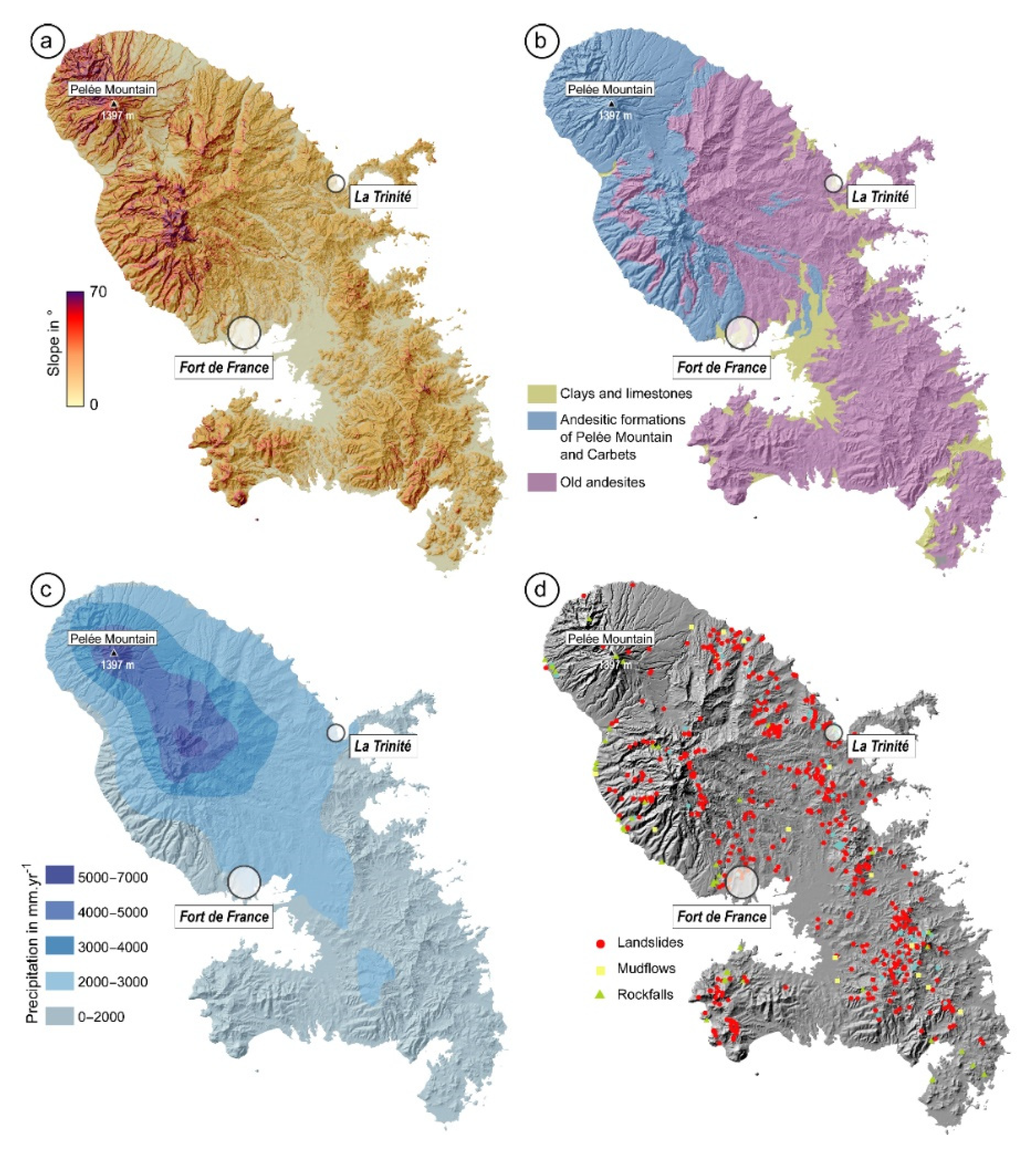
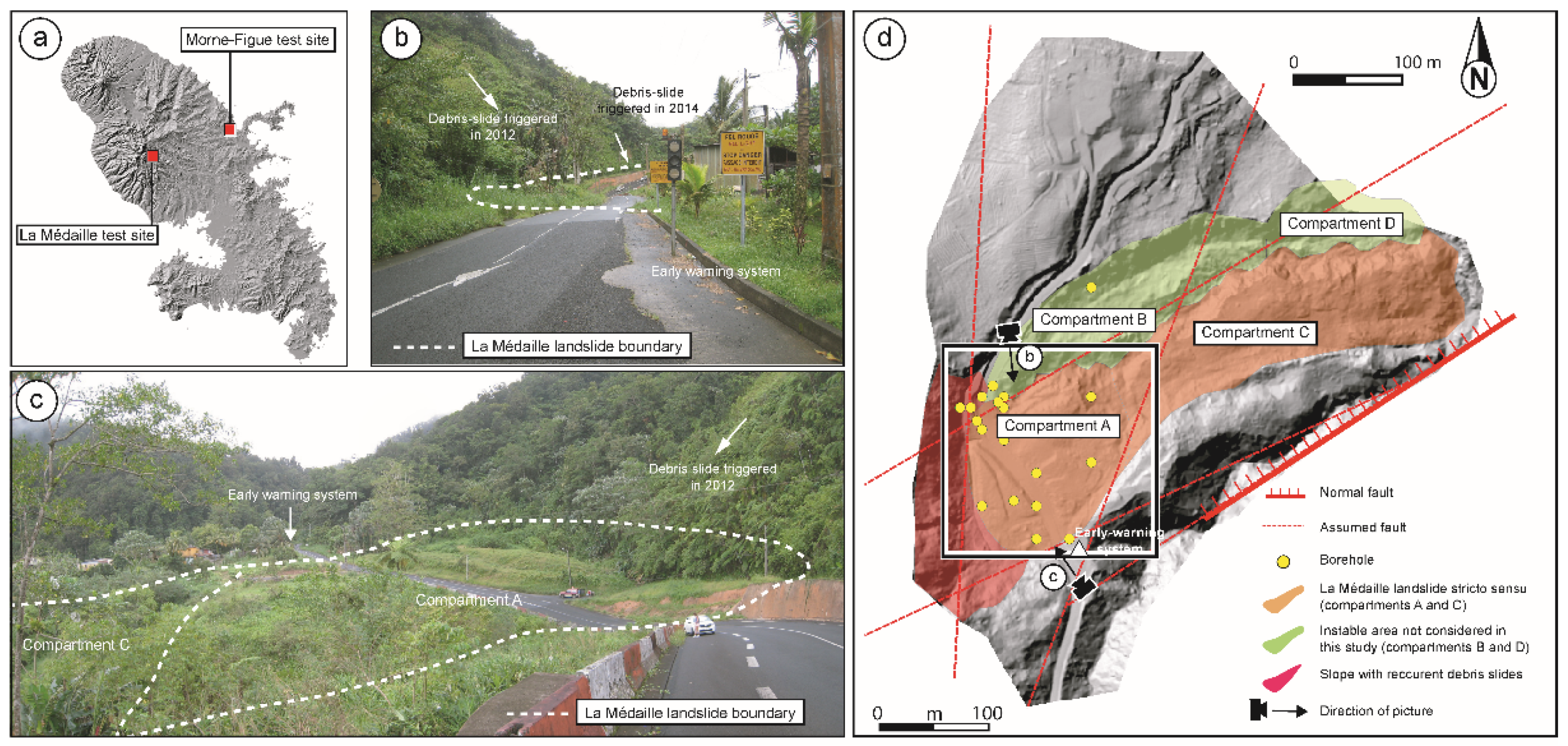

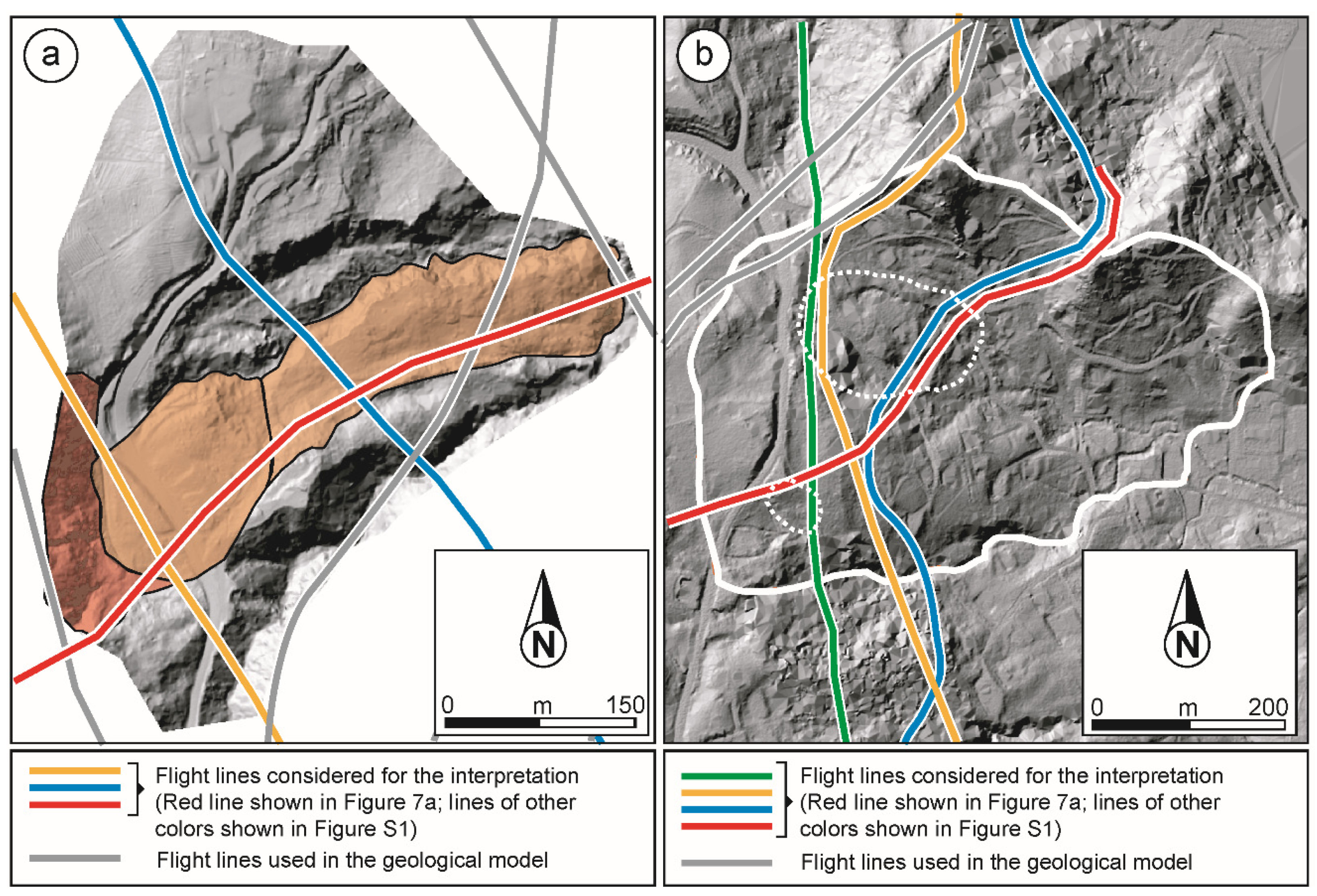
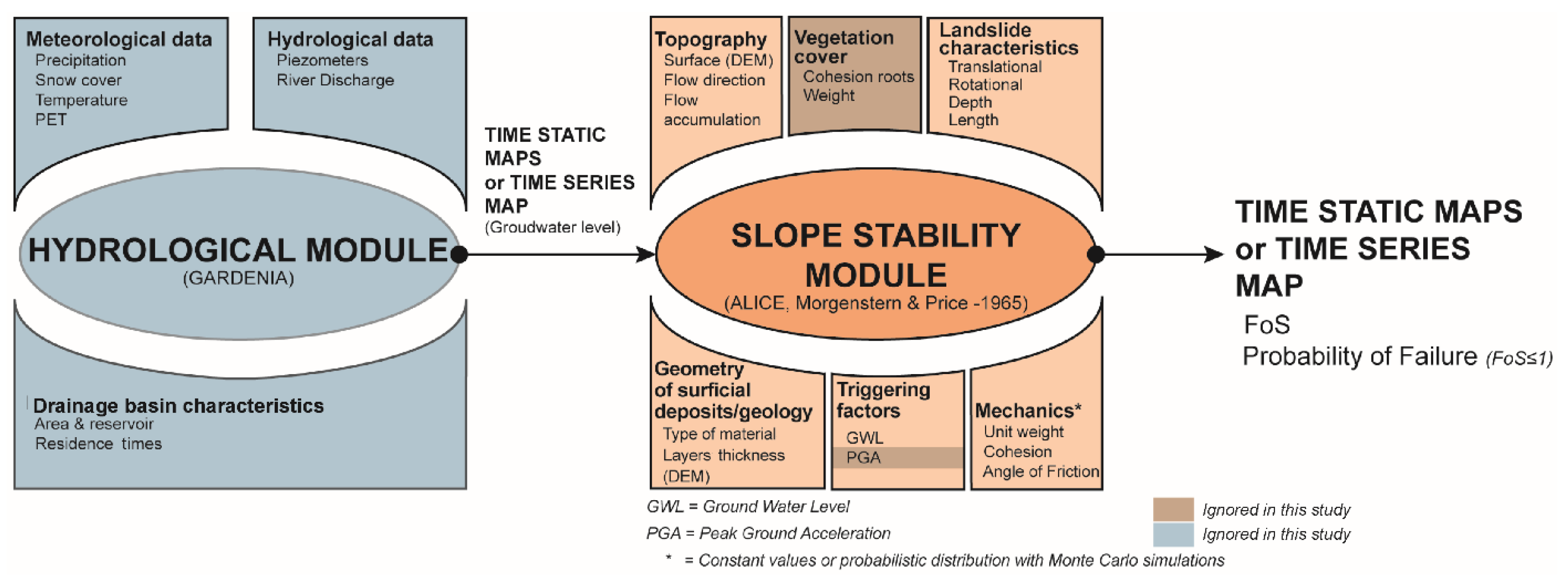

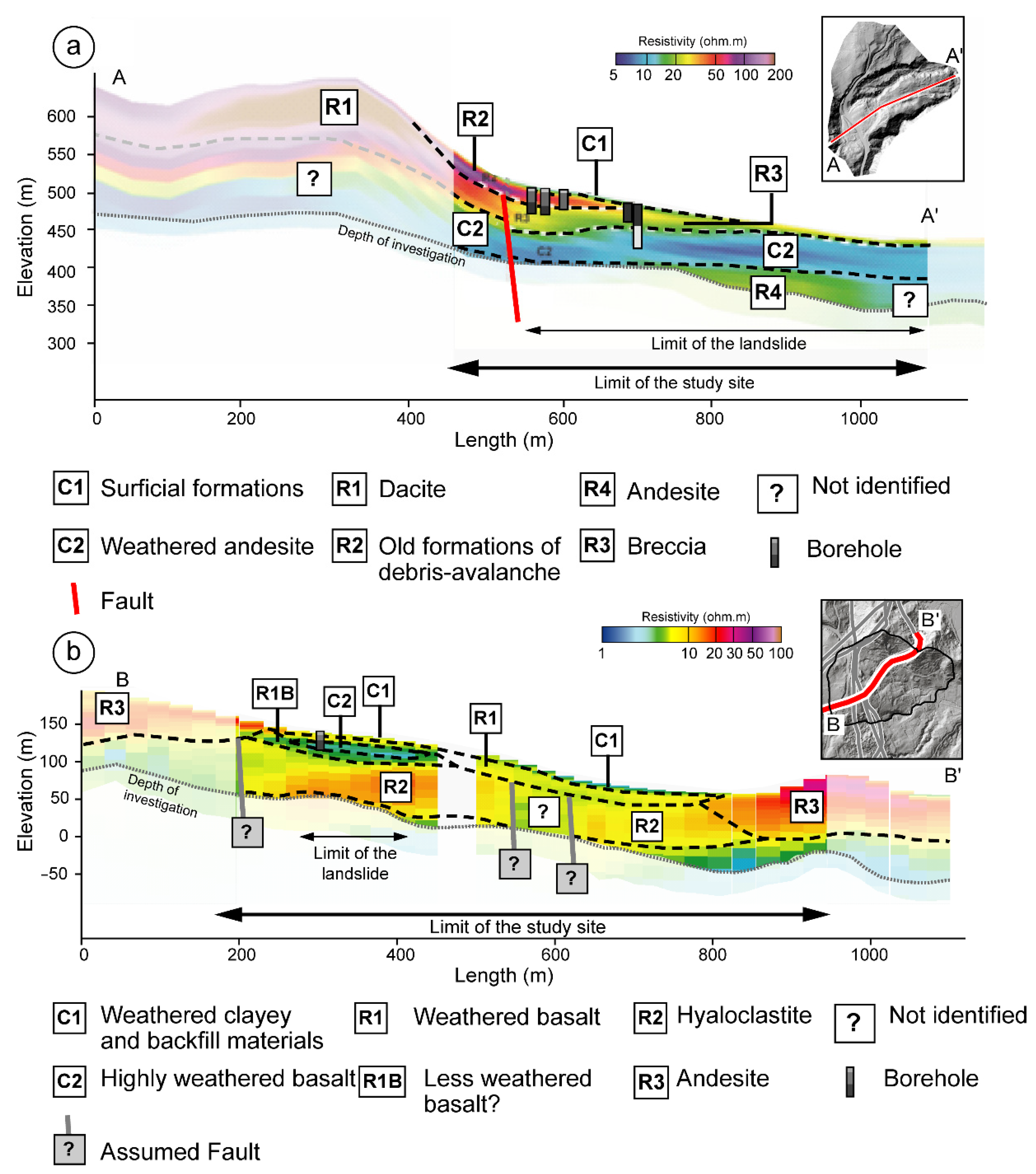
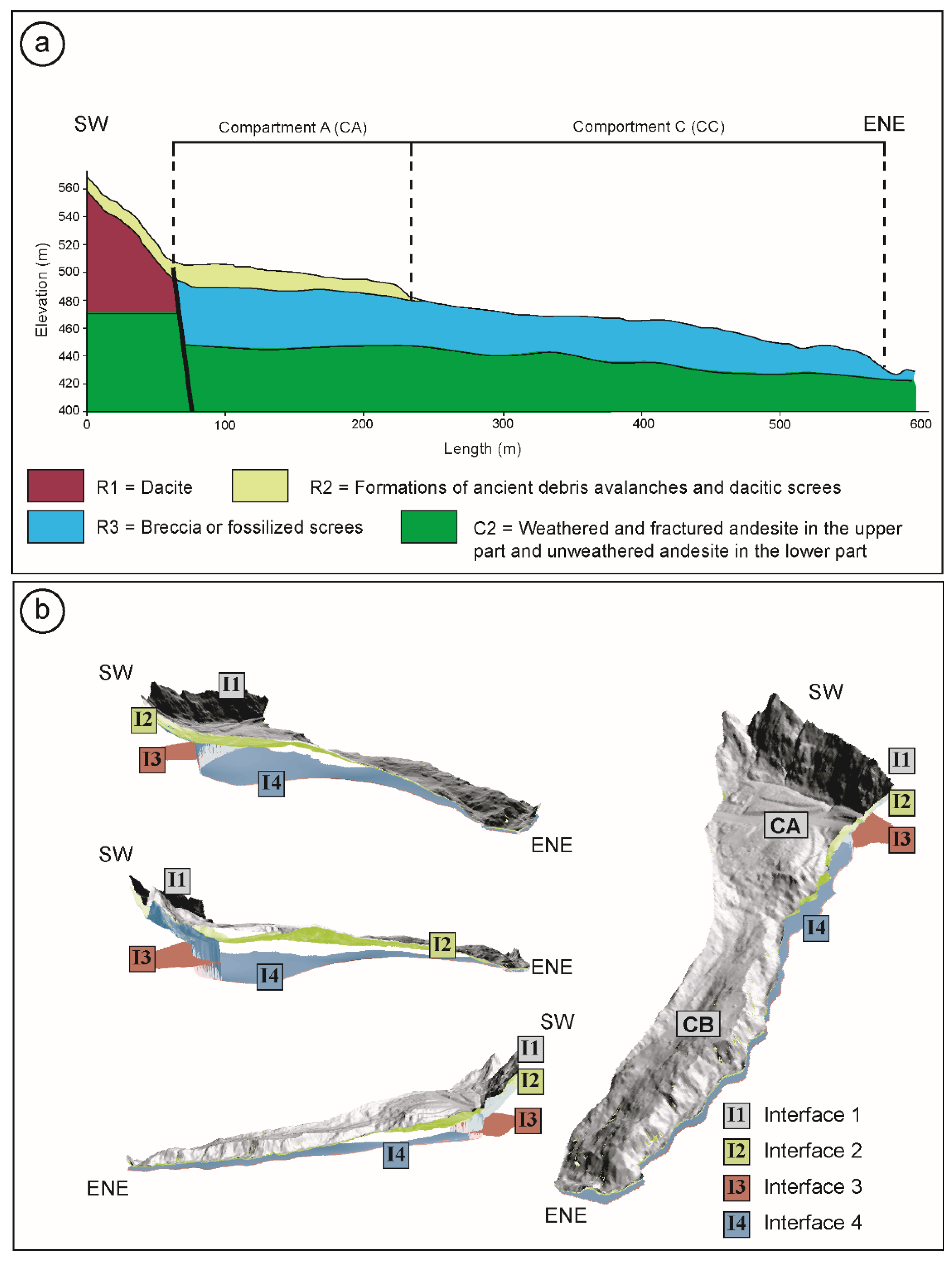
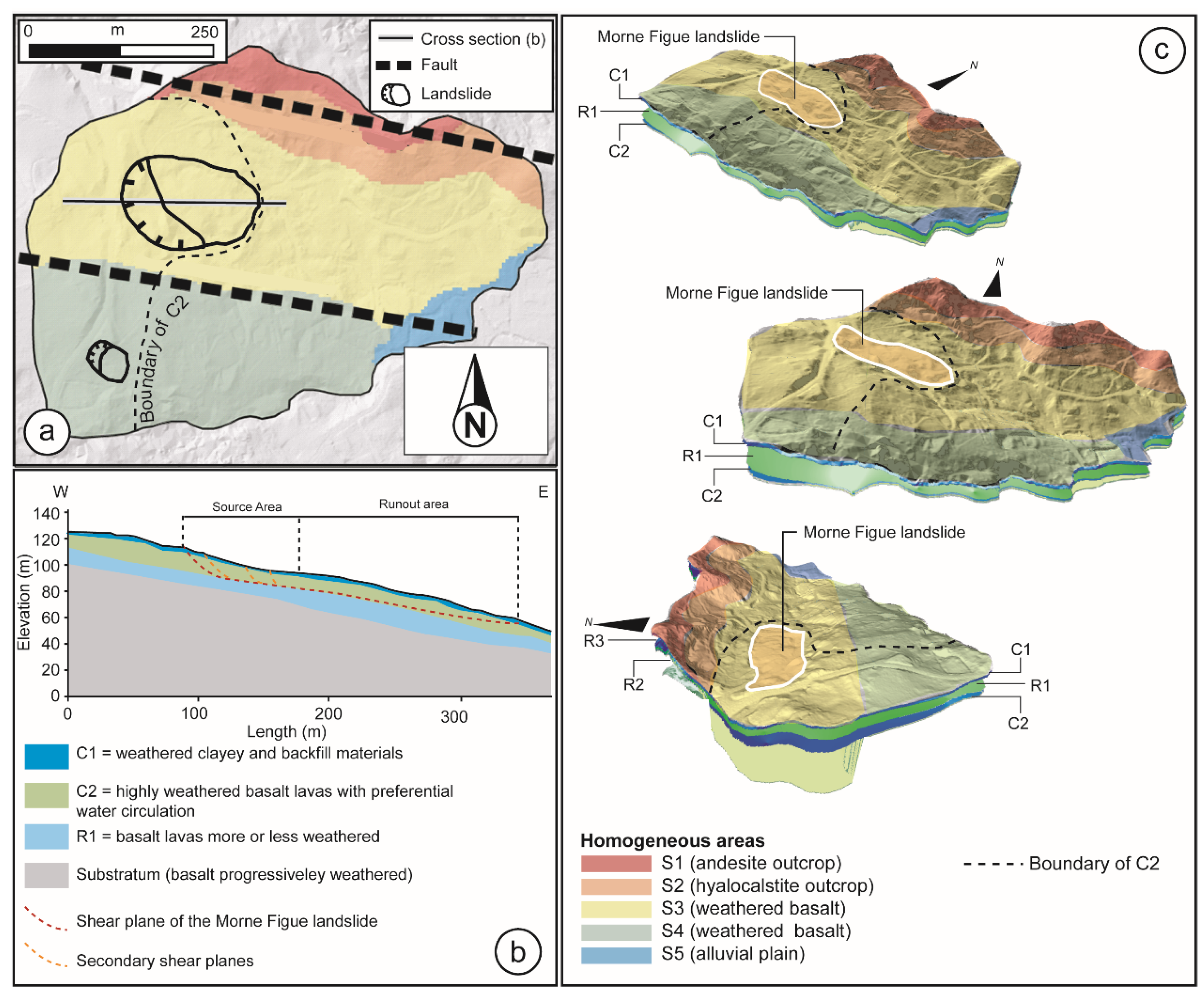
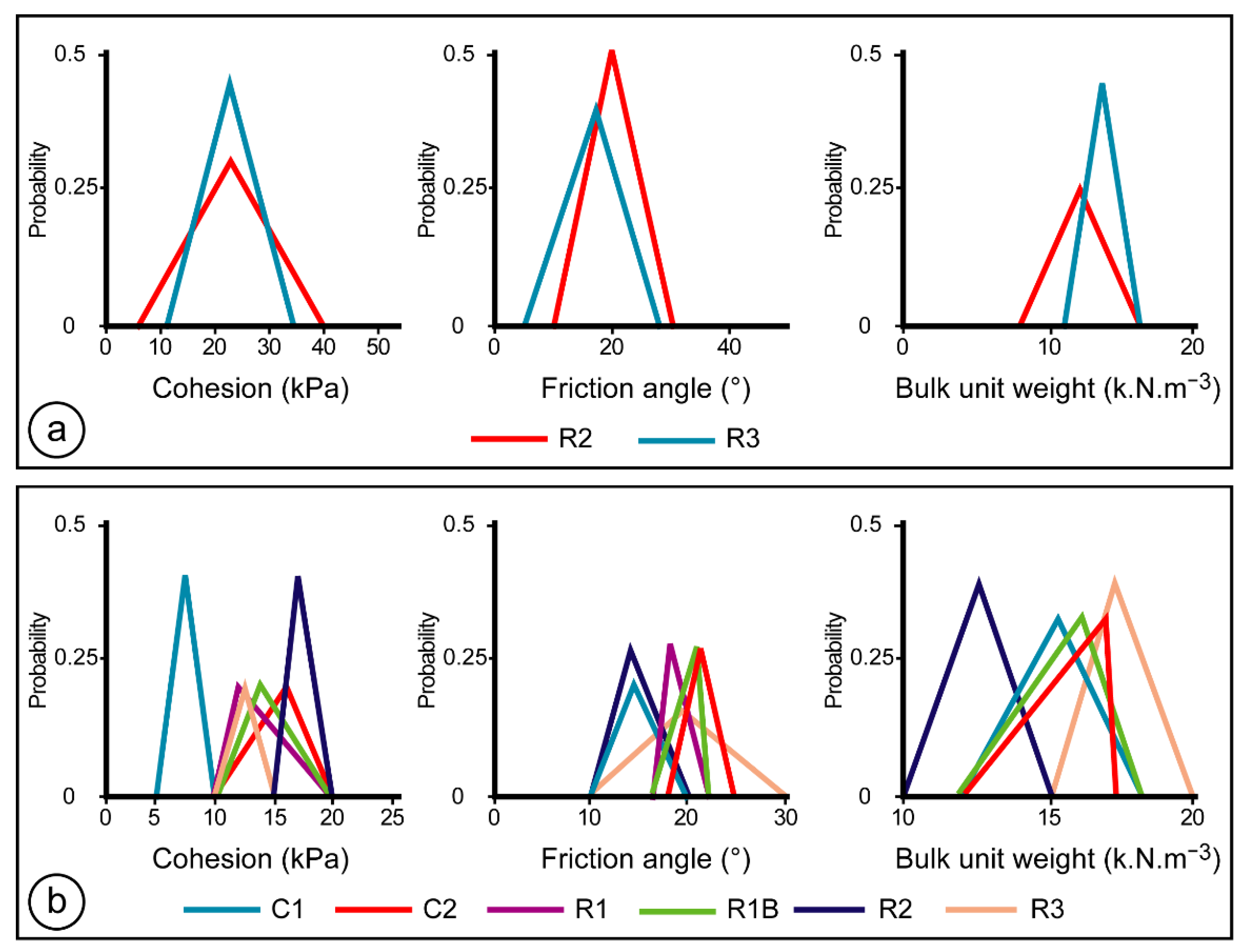
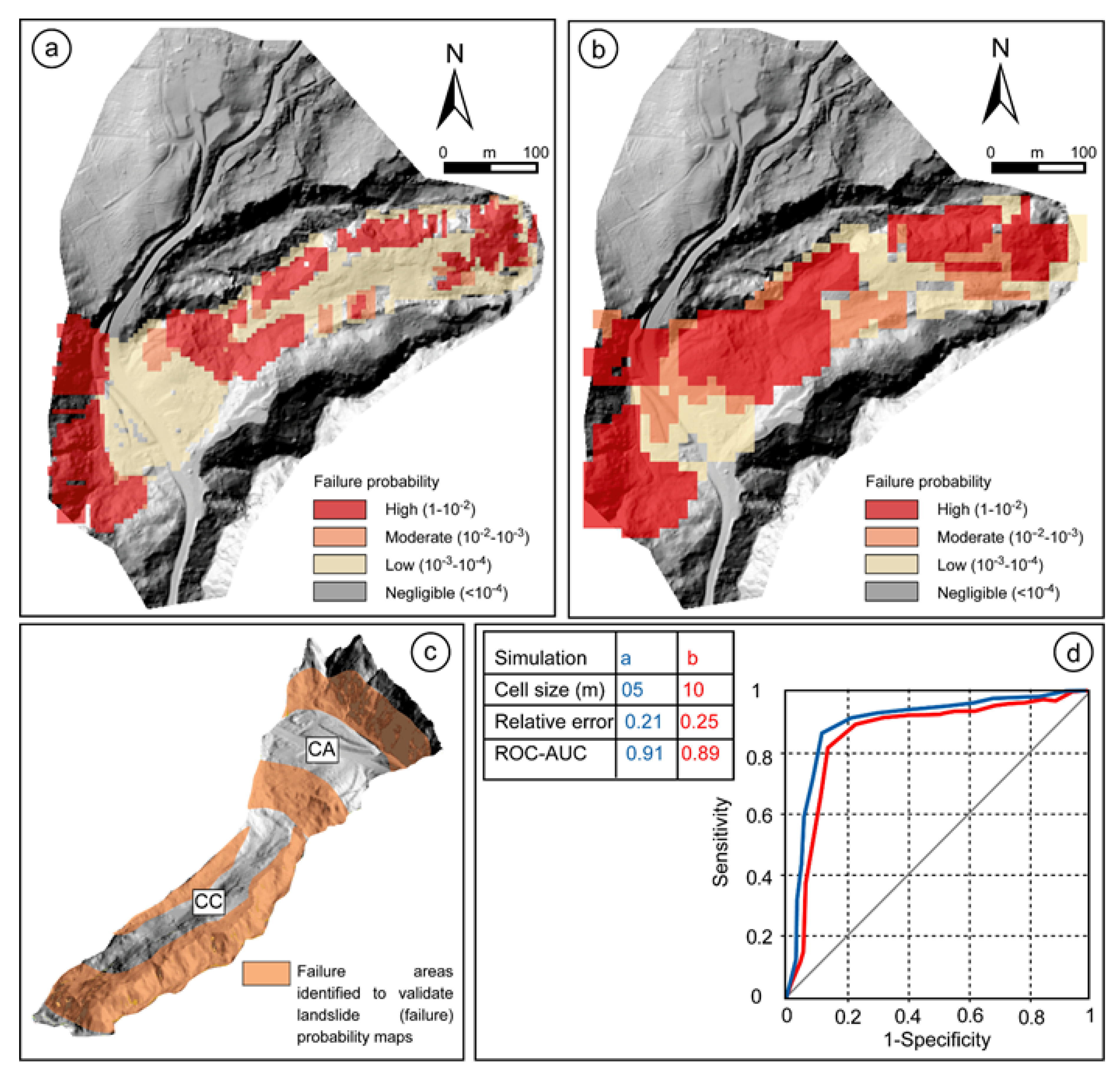



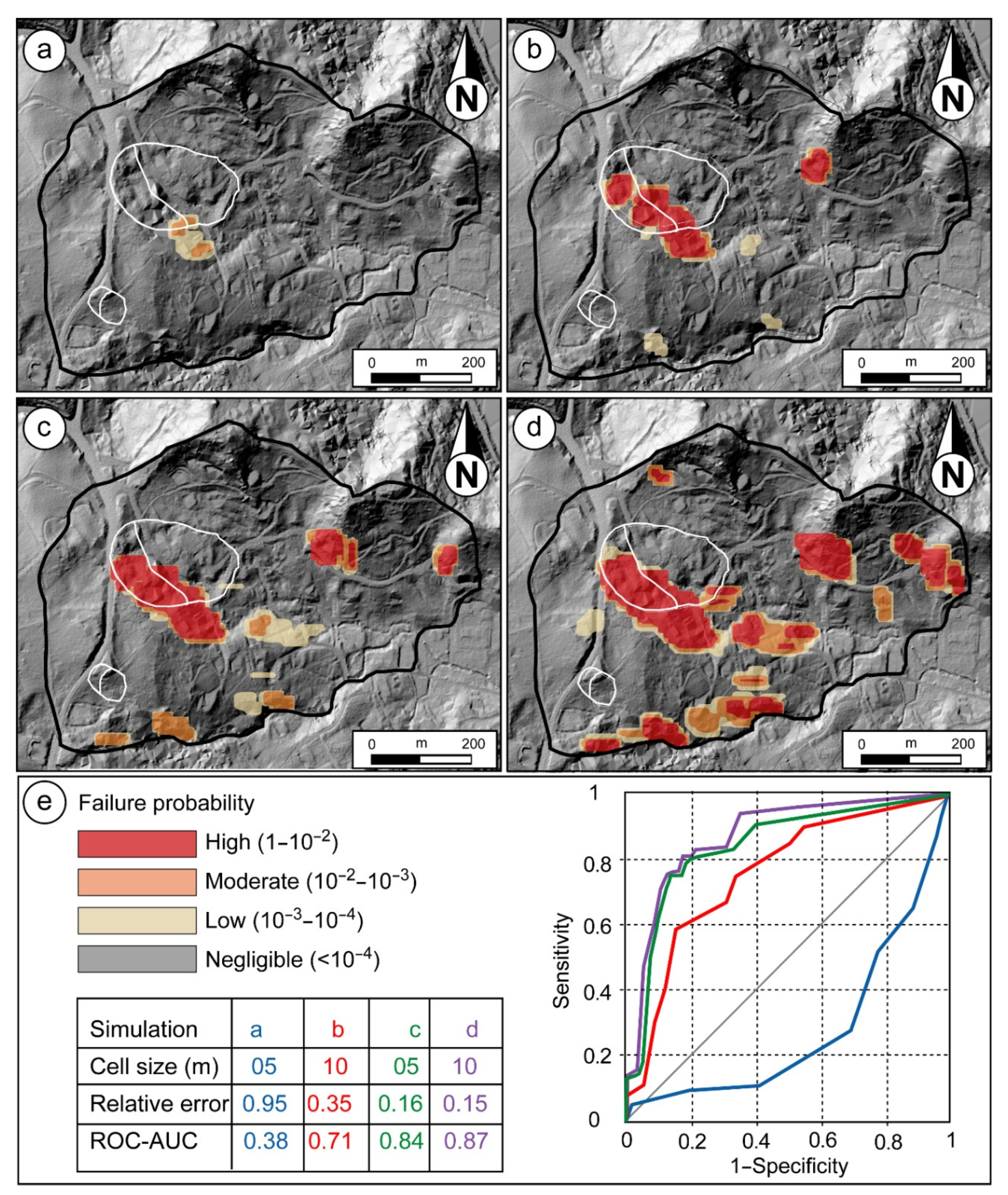
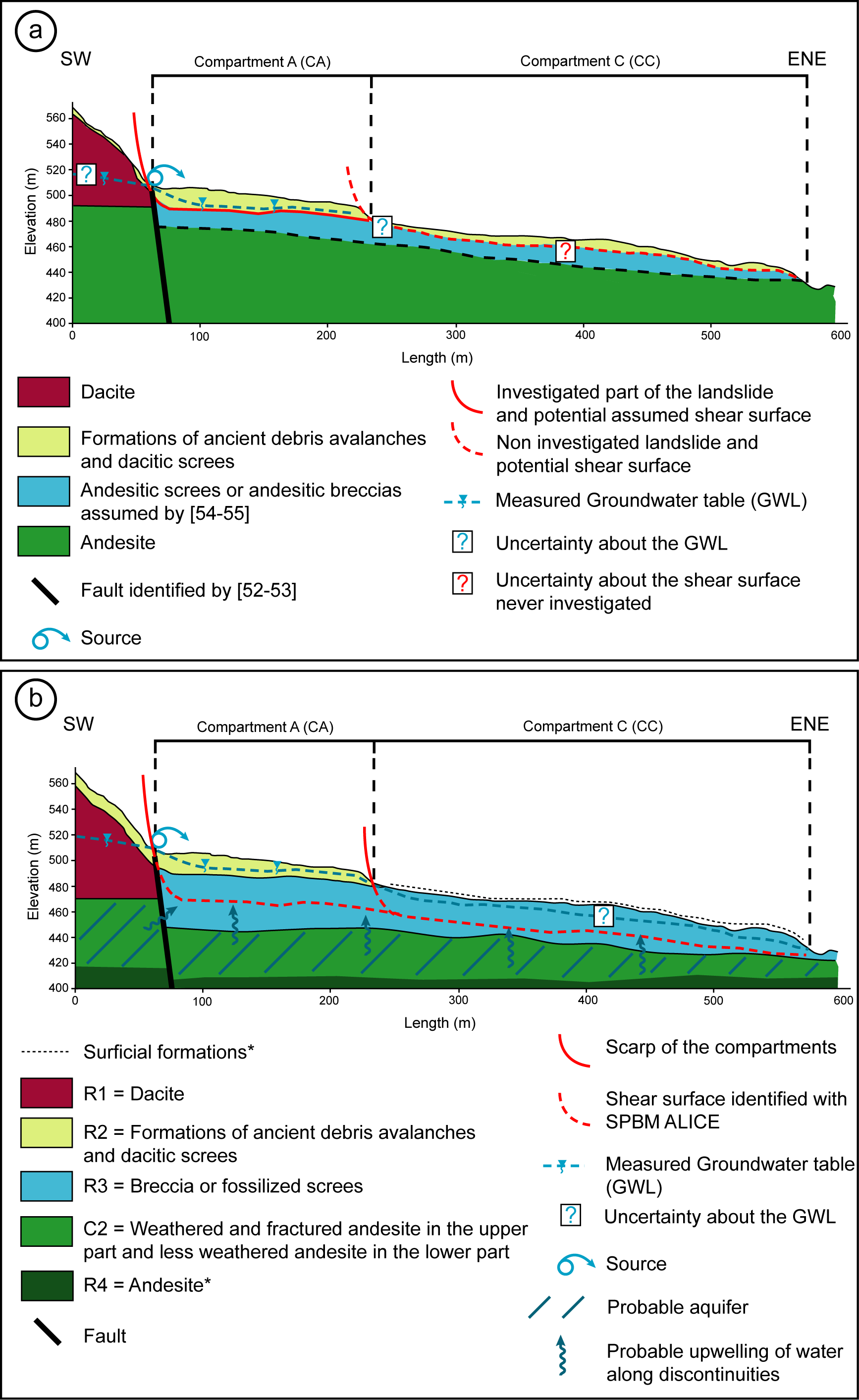
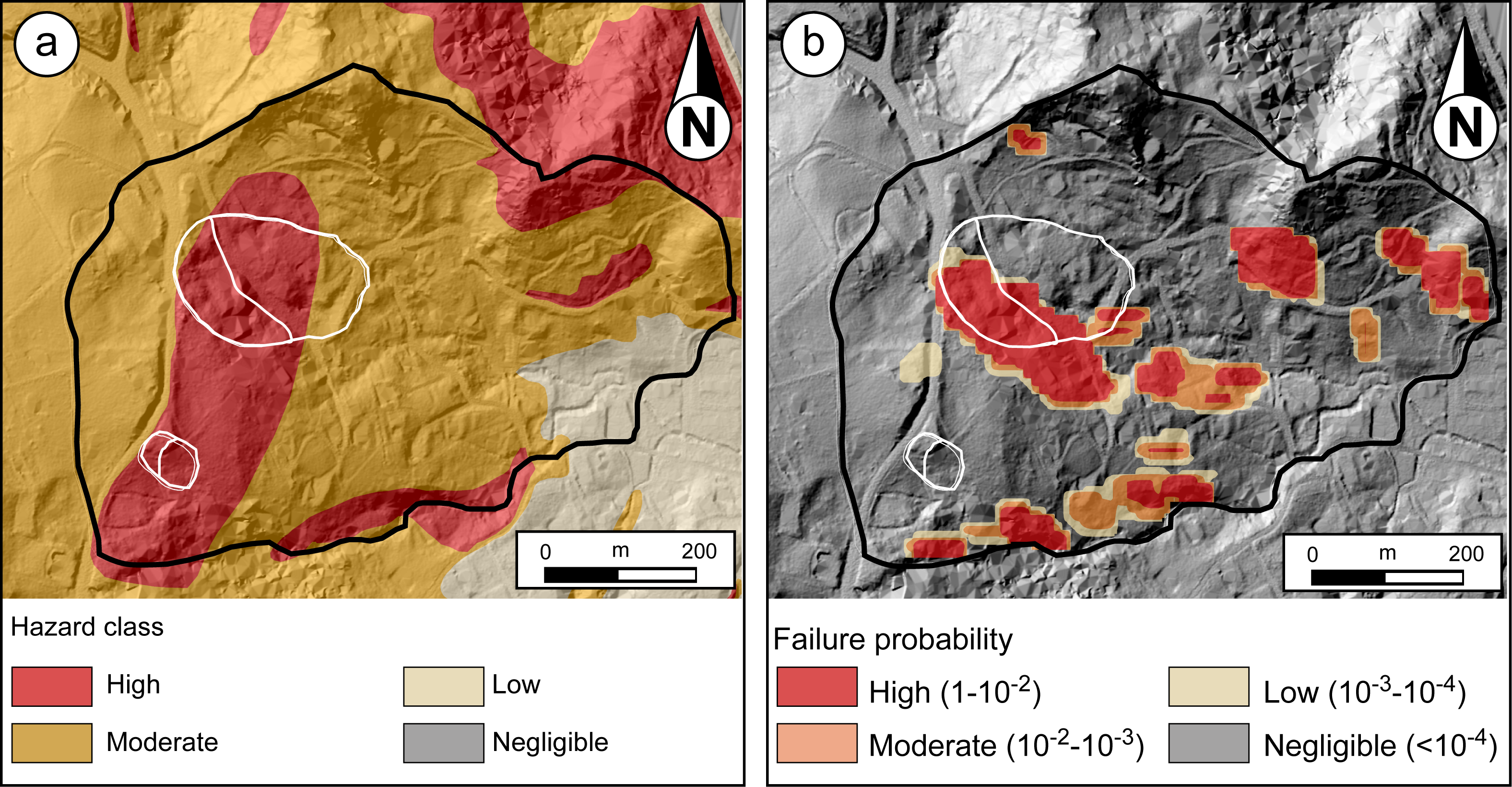
| La Médaille Landslide | Morne-Figue Area | |||
|---|---|---|---|---|
| Number (n) | Year | Number (n) | Year | |
| Boreholes | 15 | 1966, 1968, 1974, 1981, 1986, 1996 | 9 | 1981, 1982 1989, 1997 |
| Geotechnical characterization | 2 campaigns | 1981, 1983 | 1 campaign | 1989 |
| Geophysical investigations | 1 campaign (AEM) | 2013 | 2 campaigns (electrical and AEM) | 2007, 2013 |
| Hydrogeological investigations | 2 periods | Precipitation= since 1969 Piezometer = 2000 and 2002 | 1 period | Precipitation 1988–1989 Piezometer = 1988–1989 |
| Field investigations | 9 campaigns | 1966, 1968, 1974, 1981, 1986, 1996, 2002, 2014, 2016 | 7 campaigns | 1981, 1982 1989, 1997, 2007, 2016, 2017 |
| La Médaille | Morne-Figue | ||
|---|---|---|---|
| Landslide type | Deep | Moderately deep | Shallow |
| Failure length (m) | 45–50 | 45–50 | 10–15 |
| Failure depth (m) | 20–40 | 9–10 | 2–3 |
| Name | Resistivity (Ω.m) | Thickness (m) | Description |
|---|---|---|---|
| R1 | >50 | >20 | Very deep layer with high resistivity values corresponding to dacite |
| C1 | 15 | 1–3 | Surficial layers corresponding to recent weathered materials rich in clay |
| R2 | 50–55 | 4–20 | Layer with high resistivity values corresponding to dacitic screes and debris implemented by an ancient debris avalanche |
| R3 | 15–30 | 20–30 | Layer under R2 with lower resistivity values corresponding to mixed materials (breccias or fossilized screes) |
| C2 | <15 | 25–30 | Layer with low resistivity values and a thickness of approximately 30 m corresponding to weathered andesite at the bottom, which was probably caused by hydrothermal water |
| R4 | 20–25 | not identified | Formation with high resistivity values and likely corresponding to the bedrock (andesite) |
| Name | Resistivity (Ω.m) | Thickness (m) | Description |
|---|---|---|---|
| C1 | <5 | 2–4 | Weathered clayey and backfill materials |
| C2 | 1–5 | 5–10 | Highly weathered basalt lavas with preferential water circulation |
| R1 | 5–8 | 3–10 | Basalt lavas that are more or less weathered |
| R1B | 5–8 | 3–10 | Basalt lavas that are more or less weathered that are replaced laterally and at depth C2 |
| R2 | 8–11 | 15–20 | Hyaloclastite formations |
| R3 | >20 | >20 | Andesite formations that are more or less weathered |
| Formation | Thickness (m) | γ (kN.m−3) | c (KPa) | φ (°) | |||
|---|---|---|---|---|---|---|---|
| IV | SV | IV | SV | IV | SV | ||
| R1 | >20 | 25–30 | 30 | 40–50 | 40 | 30–50 | 40 |
| R2 | 2–20 | 10–17 | 11–16 | 10–37 | 12–35 | 5–30 | 5–25 |
| R3 | 20–30 | 7–17 | 8–16 | 6–50 | 6–40 | 8–35 | 10–30 |
| C2 | 25–30 | 25–35 | 28 | 35–40 | 37 | 28–47 | 40 |
| Homogeneous Area | Formation | Thickness (m) | γ (kN.m−3) | c (KPa) | φ (°) | |||
|---|---|---|---|---|---|---|---|---|
| IV | SV | IV | SV | IV | SV | |||
| S1 | R3 | >20 | 10–30 | 15–20 | 8–16 | 10–15 | 5–40 | 10–30 |
| Substratum (andesite) | infinite | 26–30 | 30 | 40 | 40 | 40 | 40 | |
| S2 | R2 | 15–20 | 05–29 | 10–15 | 5–20 | 15–20 | 1–35 | 10–18 |
| Substratum (hyaloclastite) | infinite | 29–30 | 29 | 31–35 | 35 | 31–35 | 35 | |
| S3 and S4 | C1 | 1–3 | 12–17 | 12–17 | 5–15 | 5–10 | 10–22 | 10–20 |
| R1 | 3–10 m | 10–18 | 12–18 | 1–20 | 10–20 | 16–25 | 17–22 | |
| C2 | 5–12 m | 10–18 | 12–18 | 5–25 | 10–20 | 18–25 | 18–25 | |
| R1B | 3–10 m | 10–18 | 12–18 | 5–25 | 10–20 | 16–25 | 17–22 | |
| Substratum (basalt) | infinite | 25–30/ 29–30 | 29 | 50–66/ 31–35 | 66 | 30–38/ 31–35 | 38 | |
Publisher’s Note: MDPI stays neutral with regard to jurisdictional claims in published maps and institutional affiliations. |
© 2021 by the authors. Licensee MDPI, Basel, Switzerland. This article is an open access article distributed under the terms and conditions of the Creative Commons Attribution (CC BY) license (https://creativecommons.org/licenses/by/4.0/).
Share and Cite
Thiery, Y.; Reninger, P.-A.; Nachbaur, A. Airborne Electromagnetics to Improve Landslide Knowledge in Tropical Volcanic Environments. Appl. Sci. 2021, 11, 3390. https://doi.org/10.3390/app11083390
Thiery Y, Reninger P-A, Nachbaur A. Airborne Electromagnetics to Improve Landslide Knowledge in Tropical Volcanic Environments. Applied Sciences. 2021; 11(8):3390. https://doi.org/10.3390/app11083390
Chicago/Turabian StyleThiery, Yannick, Pierre-Alexandre Reninger, and Aude Nachbaur. 2021. "Airborne Electromagnetics to Improve Landslide Knowledge in Tropical Volcanic Environments" Applied Sciences 11, no. 8: 3390. https://doi.org/10.3390/app11083390
APA StyleThiery, Y., Reninger, P.-A., & Nachbaur, A. (2021). Airborne Electromagnetics to Improve Landslide Knowledge in Tropical Volcanic Environments. Applied Sciences, 11(8), 3390. https://doi.org/10.3390/app11083390






